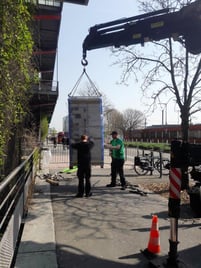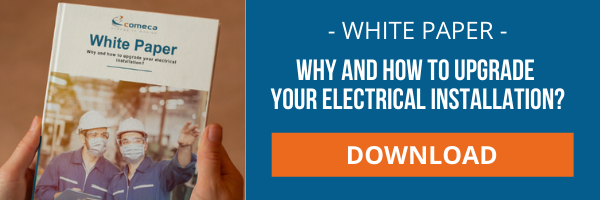Extending the LV switchboards : guaranteeing the level of safety
When you have to operate on existing installations, you must know how to assess the risk, protect yourself against it and not refrain from upgrading your LV switchboard to improve its intrinsic safety. No one is safe from the risk of an electric shock. Even if there are many solutions to protect yourself from touching a live conductor, extending your electrical switchboard will require a complete shutdown.
Traceability of the existing system: ensuring mechanical and electrical continuity
 The identification of the existing switchboard is a prerequisite for the manufacturer of the extension:
The identification of the existing switchboard is a prerequisite for the manufacturer of the extension:
- Type of the switchboard
- Intensity jdb
- Short Circuit Current
- Special features
- Service index
If this identification is not possible, an on-site visit to establish the critical dimension of the switchgear, including the busbar measurements will be required.
Reinforcement of protections on the extension
In some cases, it is possible to offer a higher level of safety than the existing board by manufacturing an extension that takes into account the latest standards and requirements in terms of safety, such as reinforced enhanced Arc Fault Containment design.
Followthe steps for the safe installation, fitting, assembly and electrical fish-plating of the extension
An overall analysis of all risks, including electrical risks, must be carried out before the work is executed. Transport, unloading, handling, mechanical assembly and electrical fish-plating are steps that require particular vigilance.
The choice of a suitable transport
The extension must be sufficiently protected for transport and handling. The manufacturer determines the most suitable packaging. Special care must be taken to secure the extension to prevent it from tipping over during transport.
Recommendations for unloading and handling

Operations that are carried out without scrupulously following the manufacturer's recommendations are a risk to the safety of goods and people.
The lifting and handling means must be adapted to the weight of the extension. To unload the extension, use the lifting points provided for this purpose. Pay attention to the centre of gravity which is different depending on the position of the main busbar. Before moving the extension, check that all doors are closed and that all equipment is in its compartment.
Before installing the extension, make sure that :
- adequate clearances on all sides of the extension comply with safety regulations
- the ground level respects the acceptable constraints for the extension
Electrical clearance guarantees safety
Holding a valid electrical permit to work, adapted to the operations to be carried out, is an essential condition for security.
The stages of electrical lockout to protect
The electrical lockout of the installation is a safety procedure designed to ensure the protection of people. For the consignment, the person in charge of consignment (BC electrical clearance) must have at his disposal equipment suitable for the voltage level of the installation and complying with the requirements of the standards in force.
1. Personal Protective Equipment (PPE)

The person in charge of consignment must equip himself with the appropriate personal protective equipment to protect himself from a dangerous environment during the consignment stages:
- Eye and face protection by protective screen
- Insulating gloves adapted to the voltage of the installation
- Insulating mat or stool adapted to the voltage
2. Voltage-free check
The voltage-free checker is a device that is specifically designed to realize the absence of voltage. It must meet the requirements of standard NF EN 61243-3 for low voltage.
It is imperative to examine its correct operation immediately before and after the voltage-free check.
3. Earthing and short-circuiting
The earthing must be carried out according to a precise procedure that starts with the connection to the earth and then to the active conductors.
The earthing device used must comply with standard NF EN 61230.
4.Certificate of consignment
In order to formalise the consignment of an installation, the consignment officer must obligatorily send a one-step consignment certificate to the works manager (B2 or B2V electrical authorisation). This certificate is equivalent to a work permit. It is an essential safety document.
Mechanical assembly and electrical connection and commissioning
Once the table has been recorded, the extension must be mechanically assembled using the fixing points provided for this purpose. Before carrying out the above operation, the alignment of the fixing holes and busbars must be checked. Under no circumstances must the assembly require any forcing on the parts. The extension must be carefully fixed to the floor.
For the assembly of the main busbar, the use of a checked torque spanner is compulsory to ensure that it is tightened to the correct torque: observe the tightening torques recommended by the manufacturer. The interconnection of the earth bars inside the switchboard must be completely completed after mechanical assembly. Finally, you can connect the auxiliary wiring between the columns.
After disconnecting the switchboard, and before reconnecting it to the power supply, carry out an insulation measurement to avoid the risk of a foreign body being left in the busbar.
If the insulation measurement complies with the expected values :
- Replace all the sheet metal and coverings that guarantee the IP rating degree of the switchboard.
- Give permission to switch on the switchboard


